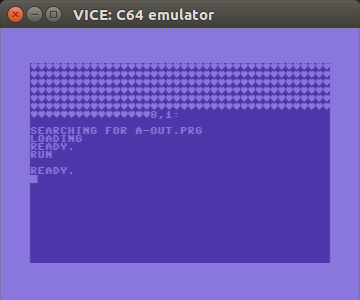5.6 KiB
SixtyPical
Version 0.20. Work-in-progress, everything is subject to change.
SixtyPical is a low-level programming language supporting a sophisticated static analysis. Its reference compiler can generate efficient code for several 6502-based target platforms while catching many common mistakes at compile-time, reducing the time spent in debugging.
Quick Start
Make sure you have Python (2.7 or 3.5+) installed. Then
clone this repository and put its bin directory on your
executable search path. Then you can run:
sixtypical
If you have the VICE emulator suite installed, you can run
sixtypical --run-on=x64 eg/c64/hearts.60p
and it will compile the hearts.60p source code and
automatically start it in the x64 emulator, and you should see:
You can try sixtypical --run-on on other sources in the eg directory
tree, which contains more extensive examples, including an entire
game(-like program); see eg/README.md for a listing.
Features
SixtyPical aims to fill this niche:
- You'd use assembly, but you don't want to spend hours debugging (say) a memory overrun that happened because of a ridiculous silly error.
- You'd use C or some other "high-level" language, but you don't want the extra overhead added by the compiler to manage the stack and registers.
SixtyPical gives the programmer a coding regimen on par with assembly language in terms of size and hands-on-ness, but also able to catch many ridiculous silly errors at compile time.
Low level
Many of SixtyPical's primitive instructions resemble those of the MOS Technology 6502 — it is in fact intended to be compiled to 6502 machine code. However, it also provides some "higher-level" operations based on common 8-bit machine-language programming idioms, including
- copying values from one register to another (via a third register when there are no underlying instructions that directly support it)
- copying, adding, and comparing 16-bit values (done in two steps)
- explicit tail calls
- indirect subroutine calls
While a programmer will find these constructs convenient, their inclusion in the language is primarily to make programs easier to analyze.
Static analysis
The SixtyPical language defines an effect system, and the reference compiler abstractly interprets the input program to check that it conforms to it. It can detect common mistakes such as
- you forgot to clear carry before adding something to the accumulator
- a subroutine that you called trashes a register you thought it preserved
- you tried to read or write a byte beyond the end of a byte array
- you tried to write the address of something that was not a routine, to a jump vector
Efficient code
Unlike most conventional languages, in SixtyPical the programmer must manage memory very explicitly, selecting the registers and memory locations to store each piece of data in. So, unlike a C compiler such as cc65, a SixtyPical compiler doesn't need to generate code to handle calling conventions or register allocation. This results in smaller (and thus faster) programs.
The flagship demo, a minigame for the Commodore 64, compiles to
a 930-byte .PRG file.
Target platforms
The reference implementation can analyze and compile SixtyPical programs to 6502 machine code formats which can run on several 6502-based 8-bit architectures:
For example programs for each of these, see eg/README.md.
Specification
SixtyPical is defined by a specification document, a set of test cases, and a reference implementation written in Python.
There are over 400 test cases, written in Falderal format for readability. In order to run the tests for compilation, dcc6502 needs to be installed.
- SixtyPical specification
- Literate test suite for SixtyPical syntax
- Literate test suite for SixtyPical analysis (operations)
- Literate test suite for SixtyPical analysis (storage)
- Literate test suite for SixtyPical analysis (control flow)
- Literate test suite for SixtyPical compilation
- Literate test suite for SixtyPical fallthru optimization
